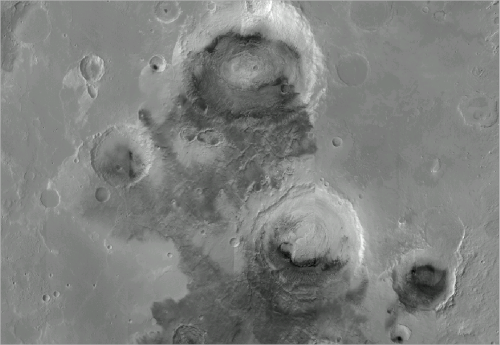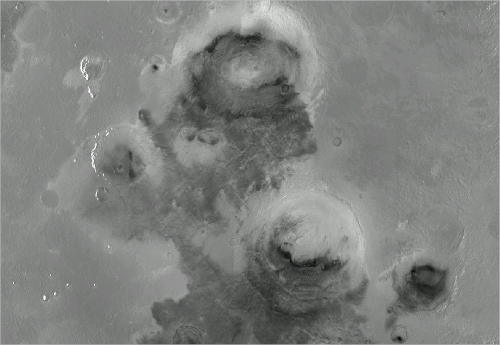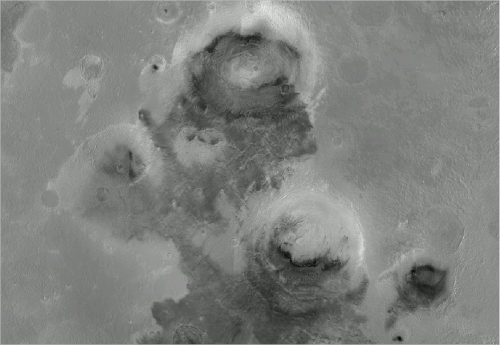Seamless albedo mosaic maps from Mars Express High Resolution Stereo Camera (HRSC) imagery
- 1Institute of Geological Sciences, Freie Universität, Berlin, Germany (sebastian.walter@fu-berlin.de)
- 2Institute of Planetary Research, German Aerospace Center (DLR), Berlin, Germany
Introduction:
Current efforts for image mosaics from the High Resolution Stereo Camera (HRSC, Jaumann, 2007) on board Mars Express are ongoing (Michael et al. 2016, Michael et al., 2019). Usually, illumination effects between adjacent single images related to the planetary curvature are reduced by using a Lambert correction and subsequent normalization to a common brightness reference. Here we present an extended correction of topography-induced shading effects by using the illumination angles with reference to the local topography represented by the digital terrain model (DTM) associated to every single HRSC scene, resulting in top-of-the-atmosphere albedo images of the surface.
Scattering models:
When used for illumination corrections taking the local topography into account, the Lambertian model and its associated cosine correction tends to over-correct on large incidence angles (under-illuminated pixels), as observed on crater slopes at low Sun angles. Therefore we do not consider it for our work but use it as a reference for comparison reasons (see Fig. 1 top -- the saturation level of one is reached at around 70° effective incidence angle).
The one-parameter model by Minnaert (Minnaert, 1941) is known for its good reproduction of the Martian surface. Depending on its power-law parameter k, the saturation effect of the correction appears at very high incidence angles only and is therefore better suited for topographic corrections. Still, in the case of HRSC, the Sun incidence angle on the ellipsoid is often higher than 60° and adding the slope angles results in incidence angles higher than 80°. This leads to very bright over-corrected pixels in highly inclined areas facing away from the Sun (see Fig. 1 middle -- depending on the k parameter, the saturation level is reached at around 80° incidence).
The correction used by Teillet et al. (1982) is well suited for topographic corrections due to its minimal amount of overcorrection (cf. Fig. 1 bottom for plots of varying parameter settings and Fig. 2 for the result). The single parameter is derived by a relation of the incidence on the ellipsoid to the mean incidince with regards to the topography.
Figure 1: Correction curves using different photometric functions; top: Lambert model; middle: Minnaert model, emission angle=0°; bottom: Teillet model, incidence on ellipsoid=60°. A reflectance of 0.3 is assumed for all plots.
Results:
We corrected a common set of HRSC images using the three mentioned scattering models and assembled a respective mosaic for each by correcting the single images for the illumination effects and then normalizing the images to TES albedo data (see Fig. 2). The parameters for the models are estimated using non-linear least square minimization for every single HRSC scene assuming constant parameters over the full image. The results for the Minnaert and the Teillet model appear very consistent by visual inspection. Due to the very high slope angles often appearing in HRSC scenes, the Minnaert model sometimes results in saturated pixels, while the Teillet model achieves the most modest levels of correction. We have not observed any advantage of the Minnaert model over the Teillet model, although it additionally includes emission angle values in the model. This lets us assume that the emission angles have a minor effect on the topography-induced illumination effects.



Figure 2: Subsets of the image mosaics; top: uncorrected image mosaic as shown in Michael et al., 2016; middle: Image mosaic with removed shading using the Minnaert scattering model, bottom: Image mosaic with removed shading using the Teillet scattering model.
Outlook:
The albedo mosaics here serve for a broad range of applications: Image classification using computer vision algorithms, geologic interpretation without influences of the topography and therefore better differentiation between albedo and shading, data fusion with uniform illumination characteristics, as well as the ability to add homogeneous shading from a uniform illumination direction for the application in Virtual Reality scenarios.
How to cite: Walter, S. H. G., Michael, G. G., Gwinner, K., and Jaumann, R.: Seamless albedo mosaic maps from Mars Express High Resolution Stereo Camera (HRSC) imagery , Europlanet Science Congress 2020, online, 21 September–9 Oct 2020, EPSC2020-18, https://doi.org/10.5194/epsc2020-18, 2020

